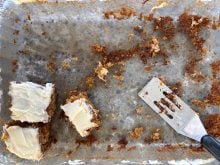Happy Thanksgiving. We have much to be thankful for. I’m thankful for the beautiful fall weather that finally allows the harvest to continue. I hope it stays nice until all the farmers have their crops in the bin.
Have you wondered why Canada and the United States celebrate Thanksgiving on different dates? The difference is due to the length of our growing seasons – much shorter in Canada than in the agricultural belt in the U.S., and so our harvest celebration is earlier.
However, this year we have such a late harvest that celebrating with our neighbours to the south might be a good idea.
Read Also

Producer profits remain under significant pressure
Manitoba farmers are facing down a double hit of high input costs, like fertilizer, and low grain prices as they harvest their next crop.
Bacon lamb roll
This recipe is one we enjoy at our house. It looks attractive on the plate, is easier to make than it may seem at first and is really tasty.
2 pounds ground lamb 1 kg
1 1/2 cups soda cracker 375 mL
crumbs
1 large onion, chopped fine
3 eggs, well beaten
1/3 cup milk 75 mL
1/2 teaspoon nutmeg 2 mL
11/2 teaspoons salt 7 mL
1/2 teaspoon pepper 2 mL
1/4 teaspoon thyme 1 mL
1/4 teaspoon allspice 1 mL
1/2 pound bacon slices 250 g
Put all ingredients, except bacon, in a bowl and mix thoroughly. Place a square of wax paper on the table. Arrange the slices of bacon, side by side, in a row in the middleof it.
Shape the meat into a roll as long as the length of the bacon slices and set on top of the bacon, in the middle. Lift up one edge of the paper to place one end of the bacon on top of the meat roll, then repeat with the other edge. Shape as firmly as possible.
Lift with the paper and roll into a baking pan long enough to fit the roll. It is easy when using the paper to do the work. Bake in 350 F (180 C) oven for one hour and 15 minutes.
Leftovers can be refrigerated and served cold with a salad or on toast.
Clamato juice
Dear TEAM: I am looking for a recipe for clamato juice. My children like it with beer when they come home. If you haven’t got one maybe a reader has. – M. H., Arran, Sask.
Dear M.H.: We were not able to find a recipe for clamato juice. Because the clam portion would be a low acid food and the tomato juice generally high acid, it would not be safe to can a recipe like clamato juice without a scientifically tested recipe.
Bernardin provides us with many tested recipes but it does not have one at this time for clamato juice. Staff there suggest home preserving tomato juice for the appropriate time in a boiling water canner or in a pressure canner adjusted for the altitude then mixing it with commercial clam juice when serving.
Bernardin has tested recipes for tomato juice and tomato-vegetable juice. You can call Bernardin at 888-430-4231 to request these recipes or the tomato juice recipe is in its Guide to Home Preserving books, available where home preserving supplies are sold.
Wheat terminology
Dear TEAM: Can you help? In my cookbook, I find oddities that I don’t understand. Are wheat berries and ripe berries the same as kernels? What is wheat meal?
To make two egg whites, how much dried egg white powder and how much water would I use? Can this be used the same as real egg white? – B.P., Shell Lake, Sask.
Dear B.P.: Wheat berry is another name for raw wheat kernels, such as you get from the farmer’s field.
Meal is coarsely ground grain that is not sifted, such as wheat meal, corn meal or oat meal. This is in contrast to finely ground, powdery grain that makes flour.
Two tablespoons (30 mL) dried egg white powder plus two tablespoons (30 mL) warm water equal the white of one large egg. Double it for two egg whites. Whole eggs are also sold in the dried form. Follow the instructions on the package.
Dried egg products can be used instead of real eggs in most dishes and in baking. They are good for camping and backpacking when no refrigeration is available.
Cucumber pickle request
M.O. of Benito, Man., requested a cucumber pickle recipe using cinnamon candy hearts. We have received some recipes from readers that contain pickling lime, an ingredient that can be dangerously caustic and is not sold in Canadian retail stores.
The pickling lime required many rinses of the soaked food to remove it. There wasconcern that some may be left on the food.
These sweet, vibrantly red pickles are an updated version of a recipe that was popular in the mid-1900s. Pickle crisp is used instead of the pickling lime.
Note that the recipe preparation takes place over five days.
Sweet red cucumber crescents
16 cups peeled, seeded large 4 L
cucumber crescents
1 pouch Bernardin Pickle Crisp 26 g
water
21/4 cups cider vinegar, five 560 mL
percent acidity, divided
1 small bottle red food colouring 5 cups granulated sugar 1.25 L
4 sticks cinnamon, each about 3 inches (7 cm)
6 ounces red hot cinnamon 170 g
candies
Wash and peel large cucumbers, halve each lengthwise. Using a spoon, scrape out seeds. Cut cucumber halves into thick 3/4 inch (two cm) crescents and put in a large, deep glass or stainless steel container. If desired, cut peeled cucumbers in rings and then remove seeds, but it is more difficult to remove seeds from each ring.
Dissolve Pickle Crisp in 16 cups (four L) water. Each 78 gram package of Bernardin Pickle Crisp contains three 26 g pouches.
Add prepared cucumbers. Cover and let stand in cool place 24 hours.
Drain cucumbers and discard the soaking solution. Place cucumbers in a large stainless steel saucepan. Add 1/2 cup (125 mL) cider vinegar and food colouring, plus just enough water to cover the vegetables.
Bring to a boil, reduce heat and simmer two hours. Drain and discard cooking liquid. Place cucumbers in a large, deep glass or stainless steel container.
In clean saucepan, combine remaining 13/4 cups (425 mL) cider vinegar, 13/4 cups (425 mL) water, sugar, cinnamon and red hot cinnamon candies and bring to a boil. Pour syrup over cucumber rings. Cover and let stand in cool place.
On each of the next three days, drain syrup from the cucumbers and bring the liquid to a boil. Pour the syrup over the cucumber rings. Do not boil cucumber rings, just the syrup. If a sweeter product is desired, add an additional one cup (250 mL) of sugar each day.
On the fourth day, place five clean 500 mL mason jars on a rack in a boiling water canner. Cover jars with water and heat to a simmer (180 F, 82 C). Set screwbands aside; heat snap lids in hot water, not boiling (180 F, 82 C). Keep jars and lids hot until ready to use.
Transfer cucumbers and syrup to a large stainless steel container and discard cinnamon sticks. Bring cucumber rings and syrup to a boil.
Pack hot cucumber rings into hot jars, leaving 3/4 inch (two cm) headspace. Add hot liquid to cover pickles to within 1/2 inch (one cm) of top rim (headspace). Using nonmetallic utensil, remove air bubbles. Wipe jar rim to remove stickiness.
Centre lid on jar; apply screwband securely and firmly until resistance is met, or fingertip tight. Do not overtighten. Place jar in canner, repeat for remaining pickle mixture and hot liquid.
Cover canner, bring water to a boil. At altitudes up to 1,000 feet (305 m) process by boiling the filled jars 10 minutes. Add an extra five minutes at 3,001 feet (916 metres), at 6,001 feet (1,831 m) and at 8,001 feet (2,441 m). Remove jars without tilting. Cool upright and undisturbed for 24 hours.
Do not retighten screw bands. Label and store jars in cool, dark place.
Current food safety recommendations indicate that all pickles must be processed to ensure all micro-organisms that cause food spoilage are destroyed and that air in the headspace is vented out to give a strong vacuum seal.
Correction
Mary’s puffed wheat cake in the Sept. 23 Western Producer should say nine cups (2.25 L) of puffed wheat rather than the 10 cups (2.5 L) as printed. It will stay together better and be easier to slice.
Alma Copeland is a home economist from Elrose, Sask., and one of four columnists comprising Team Resources. Send correspondence in care of this newspaper, Box 2500, Saskatoon, Sask., S7K 2C4 or contact them at team@producer.com.
















